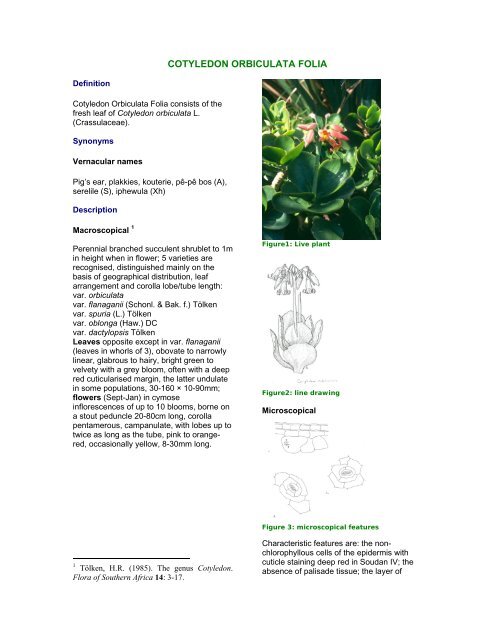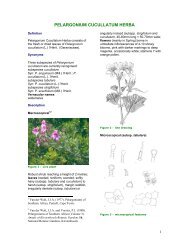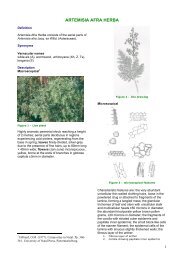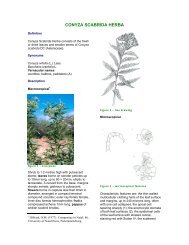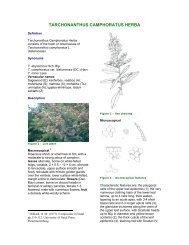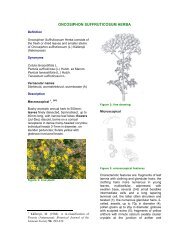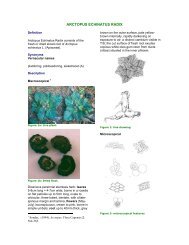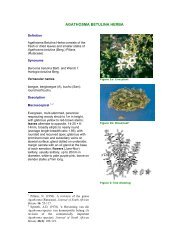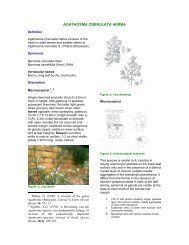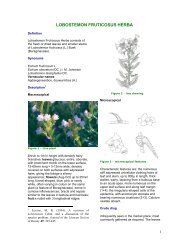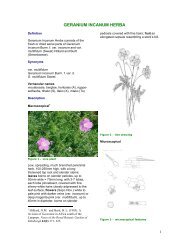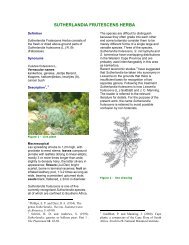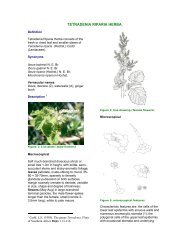COTYLEDON ORBICULATA FOLIA - PlantZAfrica
COTYLEDON ORBICULATA FOLIA - PlantZAfrica
COTYLEDON ORBICULATA FOLIA - PlantZAfrica
Create successful ePaper yourself
Turn your PDF publications into a flip-book with our unique Google optimized e-Paper software.
Definition<br />
Cotyledon Orbiculata Folia consists of the<br />
fresh leaf of Cotyledon orbiculata L.<br />
(Crassulaceae).<br />
Synonyms<br />
Vernacular names<br />
Pig’s ear, plakkies, kouterie, pê-pê bos (A),<br />
serelile (S), iphewula (Xh)<br />
Description<br />
Macroscopical 1<br />
Perennial branched succulent shrublet to 1m<br />
in height when in flower; 5 varieties are<br />
recognised, distinguished mainly on the<br />
basis of geographical distribution, leaf<br />
arrangement and corolla lobe/tube length:<br />
var. orbiculata<br />
var. flanaganii (Schonl. & Bak. f.) Tölken<br />
var. spuria (L.) Tölken<br />
var. oblonga (Haw.) DC<br />
var. dactylopsis Tölken<br />
Leaves opposite except in var. flanaganii<br />
(leaves in whorls of 3), obovate to narrowly<br />
linear, glabrous to hairy, bright green to<br />
velvety with a grey bloom, often with a deep<br />
red cuticularised margin, the latter undulate<br />
in some populations, 30-160 × 10-90mm;<br />
flowers (Sept-Jan) in cymose<br />
inflorescences of up to 10 blooms, borne on<br />
a stout peduncle 20-80cm long, corolla<br />
pentamerous, campanulate, with lobes up to<br />
twice as long as the tube, pink to orangered,<br />
occasionally yellow, 8-30mm long.<br />
1 Tölken, H.R. (1985). The genus Cotyledon.<br />
Flora of Southern Africa 14: 3-17.<br />
<strong>COTYLEDON</strong> <strong>ORBICULATA</strong> <strong>FOLIA</strong><br />
Figure1: Live plant<br />
Figure2: line drawing<br />
Microscopical<br />
Figure 3: microscopical features<br />
Characteristic features are: the nonchlorophyllous<br />
cells of the epidermis with<br />
cuticle staining deep red in Soudan IV; the<br />
absence of palisade tissue; the layer of
colourless parenchyma cells below the<br />
epidermis; the large thin-walled cells of the<br />
mesophyll containing calcium oxalate crystal<br />
sand (1); the actinocytic stomata of the leaf<br />
epidermis (2+3); the absence of lignified<br />
tissue; the cells of the mesophyll staining<br />
bright yellow-green with KOH solution.<br />
Crude drug<br />
Collected as needed or available in the<br />
marketplace as fresh leaf, bright green to<br />
grey-green in colour, often with<br />
characteristic red margin; odour faint,<br />
texture fleshy,<br />
Geographical distribution<br />
var. orbiculata: widespread in the Western,<br />
Eastern and Northern Cape Provinces and<br />
Namibia, usually on rocky slopes in open<br />
vegetation.<br />
var. spuria: restricted to the Western Cape<br />
Province, on lower mountain slopes, in<br />
depressions or on river banks.<br />
var. flanaganii: restricted to the hills around<br />
the lower Kei River in the Eastern Cape<br />
Province, on gravel slopes in scrub.<br />
var. dactylopsis: Kimberley, Hopetown,<br />
Smithfield, Bloemfontein area of the<br />
Northern Cape and Free State Province,<br />
among dolerite boulders, often on hilltops.<br />
var. oblonga: widespread but rarely common<br />
in Gauteng, Mpumalanga, Northern<br />
Province, eastern Free State Province,<br />
Kwazulu/Natal, Eastern Cape Province,<br />
eastern Swaziland, Lesotho, Mozambique,<br />
in grassland or open bushveld, often<br />
associated with rock outcrops.<br />
Figure 4: distribution map<br />
Quality standards<br />
Identity tests<br />
Thin layer chromatography on silica gel<br />
using as solvent a mixture of toluene:diethyl<br />
ether:1.75M acetic acid (1:1:1). Reference<br />
compound cineole (0,1% in chloroform).<br />
Method according to Appendix 2a.<br />
Rf values of major compounds: cineole:<br />
(blue-purple)<br />
Note The method used for most<br />
monographs yielded poor TLC results for<br />
this species. Further work is required.<br />
HPLC on C18 column, method according to<br />
Appendix 2b.<br />
Major compounds:<br />
Methanol extract: (figure 6)<br />
Retention times (mins): 16,07; 17,31<br />
Figure 6: HPLC spectrum<br />
Total ash: not more than 21.81%<br />
(determined according to the BHP 1996<br />
using 1.0g dried ground material)<br />
Purity tests<br />
Assay<br />
Not yet available<br />
Major chemical constituents<br />
Novel bufadienolide glucosides named<br />
orbicusides A-C (see a below) as well as<br />
tyledoside D, known from other members of<br />
Crassulaceae, have been isolated from the<br />
overground parts of Cotyledon orbiculata<br />
var. orbiculata 2 .<br />
2 Steyn, P.S., van Heerden, F.R. and Vleggaar, R.<br />
and Anderson, L.A.P. (1986). Bufadienolide<br />
glucosides of the Crassulaceae. Structure and
Figure 7: chemical constituents<br />
Dosage forms<br />
Peeled leaf is applied to warts and corns or<br />
may be used warm as a poultice. Fresh leaf<br />
juice may be instilled warm into the ear,<br />
applied to the skin or used locally on a<br />
painful tooth. Leaf juice is taken orally and a<br />
leaf decoction inserted per rectum as an<br />
enema.<br />
Medicinal uses<br />
Peeled leaf, applied to a corn, wart, or<br />
plantar wart and held in place with adhesive<br />
plaster, has the effect of softening hard<br />
tissue so that it may be removed after a few<br />
days of treatment. A similar treatment is<br />
used for boils, abscesses and skin<br />
eruptions. Leaf juice is used to treat earache<br />
and toothache and applied as a lotion for<br />
acne. Taken orally, fresh leaf juice has been<br />
used to treat epilepsy and a leaf decoction<br />
GR1, 11, 20.<br />
as an enema for syphilis.<br />
Pharmacology/bioactivity<br />
Despite the popularity of Cotyledon<br />
orbiculata as a traditional medicine, it has<br />
not been the subject of much in vitro or in<br />
vivo study. Owing to the incidence of<br />
stereochemistry of orbicusides A-C, novel toxic<br />
metabolites of Cotyledon orbiculata. Journal of<br />
the Chemical Society, Perkin Transactions I :<br />
1633-1636.<br />
krimpsiekte 3 in livestock feeding on this<br />
species as well as certain other members of<br />
Crassulaceae, some animal studies were<br />
undertaken 4 . These concluded that stock<br />
losses were due largely to the presence of<br />
digitalis-like principles in leaf and stem and<br />
that activity varied seasonally,<br />
geographically and according to the plant<br />
organ used (leaf or stem). The bufadienolide<br />
orbicusides 2 are probably responsible. Little<br />
local irritation of aqueous preparations was<br />
observed 4 following neutralisation of the<br />
initially acid extract and application to the<br />
conjunctival sac, tongue and skin of the<br />
rabbit.<br />
Contraindications<br />
Owing to potential toxicity as well as<br />
infraspecific variability in activity, the internal<br />
use (including enemata) of preparations of<br />
this species is not recommended until a<br />
suitable assay method can be found.<br />
Adverse reactions<br />
Cardiac effects are possible with internal<br />
use. External application appears to be<br />
unlikely to cause unwanted reactions but<br />
consideration should be given to the use of<br />
neutral preparations.<br />
Precautions<br />
Oral preparations of this species should not<br />
be taken by anyone with known or<br />
suspected cardiac conditions.<br />
Dosage<br />
External application: according to traditional<br />
methods<br />
Internal use: to be determined.<br />
3 Vahrmeier, J. (1981). Poisonous plants in South<br />
Africa that cause stock losses. Cape Town,<br />
Tafelberg.<br />
4 Sapeika, N. (1936). The pharmacological action<br />
of plants of the genera Cotyledon and Crassula.<br />
N.O. Crassulaceae. Archives Internationales de<br />
Pharmacodynamie et de Therapie : 307-328.
Copyright in this monograph resides with the authors, the South<br />
African National Biodiversity Institute, the South African Medical<br />
Research Council and the University of the Western Cape. It may<br />
not be reproduced in whole or in part without the written consent of<br />
the copyright holders.


